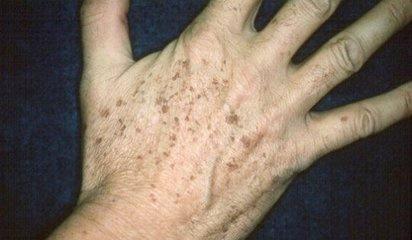
As we get older, our skin becomes a map of our lives. We know the terrain well—the freckles from childhood summers, the age spots (lentigos) that slowly appear on the backs of our hands, the familiar moles we’ve had for decades. They are the expected landmarks of a life spent in the sun.
So, it can be a surprise when you notice a new feature on this well-known map: a small, dark spot on your palm or the sole of your foot. It’s an unusual place for an age spot. Your mind might try to dismiss it, but a quiet voice of caution whispers that this is different. These new moles on your palm aren’t age spots, they’re… a specific type of mole that demands your immediate and serious attention.
To understand why, we need to talk about the unique nature of the skin on your palms and soles. Unlike the rest of your body, these areas have thick, constantly used skin with a different type of sweat gland. True age spots, caused by cumulative sun exposure, are very rare in these fully or partially shielded locations. A new, pigmented lesion here is a red flag in the world of dermatology.
The Prime Suspect: Acral Lentiginous Melanoma
The most critical reason to pay attention to a new mole on your palm or sole is the possibility of acral lentiginous melanoma (ALM).
This is a type of melanoma that specifically occurs on the palms of the hands, the soles of the feet, or under the nails (where it might appear as a dark streak). Unlike other melanomas, it is not strongly linked to sun exposure. This is why it can occur in people of all skin tones, and is, in fact, the most common form of melanoma in people with darker skin.
Because it appears in a less obvious location and doesn’t fit the typical “sun-related cancer” narrative, it is often overlooked until it has advanced. This is why knowing the signs is so crucial.
How to Tell the Difference: The ABCDEs and the “Ugly Duckling”
You can’t diagnose this yourself, but you can be a smart detective. Use the classic ABCDE rule for melanoma, but apply it with extra vigilance to your palms and soles:
- Asymmetry: One half of the spot does not match the other.
- Border: The edges are irregular, ragged, notched, or blurred.
- Color: The color is not uniform. It may have different shades of brown, black, tan, red, white, or blue.
- Diameter: While melanomas can be small, they are often larger than the size of a pencil eraser (6mm) by the time they are diagnosed. However, any new, changing spot on the palm or sole is significant, regardless of size.
- Evolving: The spot is changing in size, shape, or color.
For areas like the palms and soles, there’s an even more critical rule: the “Ugly Duckling” sign. Look at all the other spots on your hands and feet. Does this one look completely different? Does it stand out as an outlier? That is your single most important clue.
Other Possibilities: The Less Sinister Explanations
While ALM is the most serious concern, a new spot could be other things. It could be a simple blood blister from minor, unnoticed trauma. It could be a wart, though these are typically more raised and textured. It could be a benign acral nevus (a mole that happens to be on the palm or sole).
But here is the golden rule: You are not qualified to make this distinction. The stakes are too high.
Your Action Plan: Don’t Wait, Investigate
If you discover a new, dark spot on your palm or sole, your course of action is clear and urgent.
- Do Not “Watch and Wait.” This is not a “see if it goes away in a few weeks” situation. Time is of the essence with any potential melanoma.
- Schedule an Appointment with a Dermatologist Immediately. This is not a job for your primary care physician. You need a skin specialist. When you call, say, “I have a new, pigmented lesion on my palm that I need to have evaluated.”
- What to Expect: The dermatologist will examine the spot, likely with a dermatoscope—a special magnifying light that allows them to see structures beneath the skin’s surface. If they are at all concerned, they will recommend a biopsy. This is a simple, in-office procedure where a small sample of the tissue is removed and sent to a lab for definitive analysis.
- Breathe. Remember, the vast majority of biopsied moles turn out to be benign. But the peace of mind that comes from a professional diagnosis is priceless, and the early detection of a serious issue is life-saving.
A new mole on your palm is your body’s way of posting a billboard in a place you’re guaranteed to look. It is a signal that demands to be seen and taken seriously. While it may turn out to be harmless, treating it as a potential emergency is the only rational response. By acting swiftly and decisively, you are using your wisdom and vigilance to protect your health. You are ensuring that a small, dark spot remains just that—and nothing more.